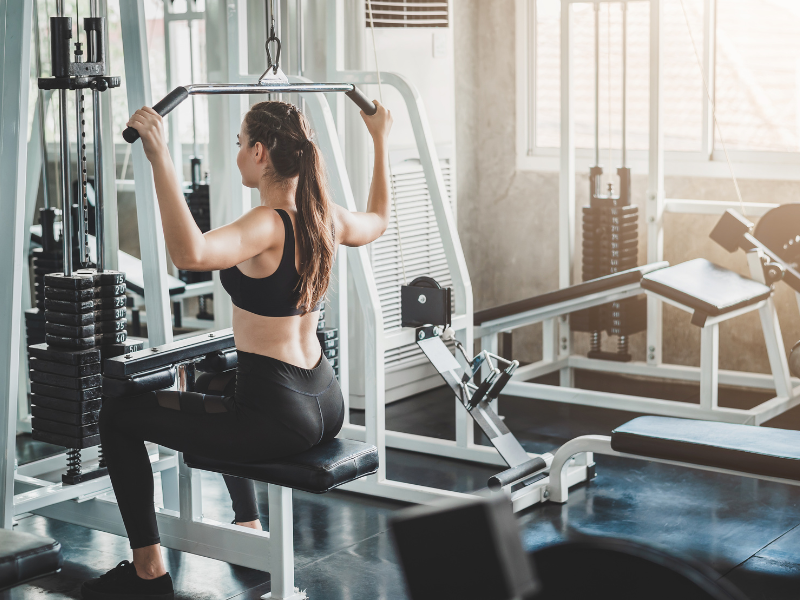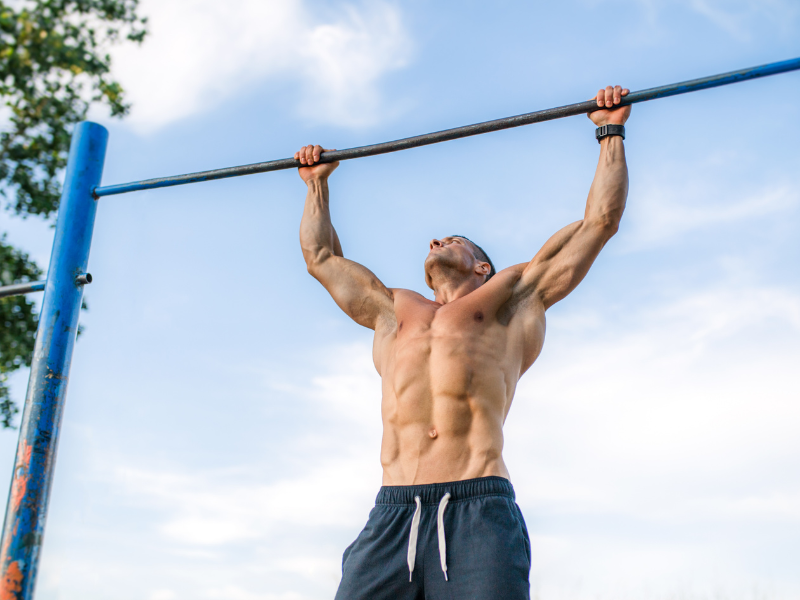




A strength training program isn’t truly complete without vertical pull exercises, especially if you’re eager to boost your upper body strength and sculpt a well-defined physique with back workouts! Get ready to dive into the world of vertical pulling exercises, where we’ll uncover their amazing benefits and introduce some exciting beginner-friendly workouts.
What Are Vertical Pull Exercises?

Any type of exercise or movement that involves pulling resistance from pulling your body up in a vertical path can be categorized as a vertical pull exercise. Beyond body weight exercises, these are usually executed with the help of tools and equipment like pull-up bar, resistance band, etc. There are also horizontal pulling exercises that require pulling your weight horizontally towards you from straight in front.
Muscles Worked in Vertical Pulling Exercises
Vertical pull exercises mainly activate the arms, shoulders and upper back. These include specific muscles like:
- Erector spinae
- Trapezius
- Latissimus dorsi or Lats
- Trapezius
- Biceps and forearms
- Rhomboids
- Rear deltoids
- Rotator cuffs
You may also like:The Best Pull Day Workout Routine To Target The Right Muscles
Benefits of Vertical Pull Exercises
Vertical pull exercises involve pulling weight or resistance toward your body in a vertical plane. Here are some key benefits:
Improved Posture

By targeting and strengthening the upper back muscles, vertical pull exercises can significantly improve posture. They help pull the shoulders back, promoting an upright stance [1].
Increased Upper Body Strength

These exercises effectively build strength in the upper back, shoulders, and arms [2], enhancing your ability to perform everyday tasks and physical activities.
Reduced Risk of Injury

Strengthening the upper back muscles provides stability and support to the shoulders and spine, helping to protect against injuries such as strains or sprains [3].
Enhanced Aesthetic Appearance

Vertical pull exercises contribute to a more defined upper body, fostering a stronger, more athletic look.
4 Beginner-Friendly Vertical Pull Exercises
1. Pull-ups
Pull-ups are highly beneficial for strengthening the arms and back. They also enhance overall body coordination and different grip variations can target various muscle groups. However, because of the high physical demand this exercise is not recommended for people with poor athletic ability.

How to do pull-ups:
- Grip the bar with hands slightly wider than shoulder-width and arms fully extended.
- Engage your back by pulling your shoulder blades down as you lift your body until your chin is slightly above the bar. Cross your feet to maintain body stability.
- Lower your body slowly, controlling the descent to maximize muscle engagement. Keep your core engaged to maintain stability and avoid leaning back during the exercise.
2. Lat Pulldown

The lat pulldown is an effective exercise for building upper body strength and enhancing posture. It targets the back, chest, and arm muscles, promoting a more coordinated and upright upper body.
How to do lat pulldown:
- Stabilize your shoulder joints by contracting your scapulae inward, which minimizes shoulder strain and enhances pectoral muscle activation.
- Maintain a straight wrist position, ensuring that your elbows, wrists, and the bar are aligned to increase safety and prevent injuries.
- Inhale as you lower the bar (eccentric phase) and exhale as you lift it (concentric phase) to maintain balance and effectiveness.
- Engage your lower body to provide additional power during the lift.
3. High-Low Cable Row
Both high pull-down training and rope rowing are very good vertical pull exercises to find a good sense of back force. The high-low cable row is an excellent vertical pull exercise that strengthens the back while improving overall muscular coordination.

How to do high-low cable row:
- Sit on the rower and position your feet on the platform or crossbar, ensuring your knees are slightly bent.
- Lean forward with your back straight and hold the V-handle in a natural position.
- With arms extended, pull the handle toward your body, keeping your torso fixed and allowing your elbows to touch your abdomen. Exhale during this movement.
- Hold the contraction for a second before slowly returning to the starting position while inhaling.
You may also like other great back workouts:
Pendlay Row vs Barbell Row: Differences and Benefits
Chin-ups

Chin-ups are a variation of pull-ups that place greater emphasis on the biceps while effectively targeting the back muscles, especially the lats.
How To Do Chin-Ups
- Grip the bar with palms facing you, shoulder-width apart.
- Pull your body up until your chin is above the bar, focusing on engaging your biceps and back.
- Lower yourself slowly back to the starting position, maintaining control throughout the movement.
Incorporating these vertical pull exercises into your routine can lead to significant improvements in strength, posture, and overall physical fitness.
You may also like:
Push Pull Legs Workout Routine PDF
Final Thoughts
We hope that this beginner’s guide to vertical pulling exercise can help you decide if you’re choosing to add it to your workout routine. It acts as a great addition to any full body workout or upper body workout routine for building strength and a balanced physique. For more such effective exercises that you can follow, check out the JustFit app!
Are shrugs a vertical pull?
Are bicep curls vertical pulls?
Is a lat pullover a vertical pull?
Calisthenics Academy. (2022, November 14). 6 best vertical pull exercises at home: The best moves to tone your arms and back - bodyweight training arena. Bodyweight Training Arena - Your Ultimate Resources for Calisthenics Training. Available at: https://bodyweighttrainingarena.com/vertical-pull-exercises-at-home/
Using vertical pull exercises to reduce low back pain. Mend Colorado. (2023, August 7). Available at: https://www.mendcolorado.com/physical-therapy-blog/2023/8/7/utilizing-the-vertical-pull-to-reduce-your-low-back-pain/#:~:text=Incorporating%20vertical%20pull%20exercises%20into,injury%2C%20and%20enhanced%20core%20stability.





